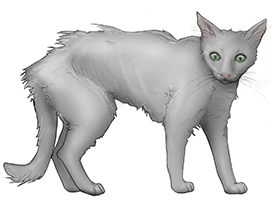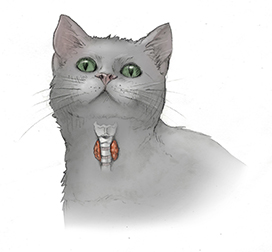Hyperthyroidism in Cats
Hyperthyroidism is a common disease in cats, and mostly afflicts cats middle-aged and older.
Also called thyrotoxicosis, hyperthyroidism is caused by an increase in production of thyroid hormones (known as T3 and T4) from an enlarged thyroid gland in a cat’s neck. In most cases, enlargement of thyroid glands is caused by a non-cancerous tumor called an adenoma. Some rare cases of hyperthyroid disease are caused by malignant tumors known as thyroid adenocarcinomas. Although the cause of feline hyperthyroidism is not known, possible contributing factors include deficiencies or excesses of certain compounds in the diet and chronic exposure to thyroid-disrupting chemicals in food or the environment.
Thyroid hormones affect nearly all of the organs in the body; therefore, thyroid disease often causes secondary problems.
Clinical Signs
Cats afflicted with hyperthyroidism usually develop a variety of signs that may be subtle at first but that become more severe as the disease progresses. The most common clinical signs of hyperthyroidism are weight loss, increased appetite, and increased thirst and urination. Hyperthyroidism may also cause vomiting, diarrhea, and hyperactivity. The coat of affected cats may appear unkempt, matted, or greasy (see Figure 1).
Diagnosis
A veterinarian who suspects a cat has a thyroid problem will conduct a physical examination and palpate the cat’s neck area to check for an enlarged thyroid gland (see Figure 2). The cat’s heart rate and blood pressure may also be checked. If thyroid disease is a possibility, your veterinarian will likely order a blood chemistry panel and an analysis of thyroid hormone levels. Most cats with hyperthyroidism have elevated levels of the thyroid hormone T4 in their bloodstream, but a small percentage of cats with hyperthyroidism have T4 levels within the normal range. If your cat does not have elevated T4 levels but your veterinarian still suspects your cat has hyperthyroidism, additional tests may be recommended. Since hyperthyroidism can predispose a cat to other conditions, it is important to evaluate general health, with particular focus on the heart and kidneys. A blood chemistry panel and urinalysis will provide information about other organs and provide your veterinarian with an overall picture of your cat’s health.
Treatment
There are four treatment options for feline hyperthyroidism: medication, radioactive iodine therapy, surgery, and dietary therapy. Each treatment option has its advantages and disadvantages. The treatment a cat receives for hyperthyroidism will depend on specific circumstances, including the patient’s overall health status, the owner’s ability and willingness to medicate the cat regularly, and financial considerations.
Medication
Anti-thyroid drugs act by reducing the production and release of thyroid hormone from the thyroid gland. These medications do not provide a cure for the disease, but they do allow either short-term or long-term control of hyperthyroidism. The advantages of medication are that the drugs are readily available and relatively inexpensive. Some cats may experience side effects from medication, however, including vomiting, anorexia, fever, anemia, and lethargy. Lifelong treatment, usually involving twice-daily oral dosage, will be required, and for some owners and cats, this dosage schedule may be difficult to maintain. Antithyroid medications are also available in a gel that can be applied to the skin. The effectiveness of this transdermal gel is acceptable in most cases. Regardless of the medication, blood tests should be conducted periodically during treatment to evaluate whether the therapy is effective and to monitor kidney function and for potential side effects.
Radioactive Iodine Therapy
When available, radioactive iodine therapy is the treatment of choice for cats with hyperthyroidism. During treatment, radioactive iodine is administered as an injection and is quickly absorbed into the bloodstream. The iodine, which is required for the production of both T3 and T4, is taken up by the thyroid gland and the emitted radiation destroys the abnormal thyroid tissue without damaging the surrounding tissues or the parathyroid glands. The majority of cats treated with radioactive iodine have normal hormone levels within one to two weeks of treatment.
The advantages of radioactive iodine therapy are that the procedure most often cures hyperthyroidism, has no serious side effects, and does not require anesthesia. It does, however, involve the handling and injection of a radioactive substance that is only permitted at facilities specially licensed to use radioisotopes. The radioactivity carries no significant risk for the cat, but precautionary protective measures are required for people who come into close contact with the cat. A treated cat has to remain hospitalized until its radiation level has fallen to within acceptable limits. Usually this means that the cat will need to be hospitalized for between three and five days after treatment. Because of strict treatment guidelines, most facilities will not allow visitors during this quarantine period.
Radioactive iodine therapy is curative within three months of therapy in approximately 95 percent of all hyperthyroid cases. In cases where radioactive iodine therapy is not successful, the treatment can be repeated. Rarely, a permanent reduction in thyroid-hormone levels called hypothyroidism occurs after radioactive iodine treatment. If this is accompanied by clinical signs such as lethargy, obesity, and poor hair coat, then thyroid hormone supplementation may be required.
Surgery
Removal of the thyroid glands, called surgical thyroidectomy, is a relatively straightforward surgical procedure that has a good success rate. The advantage of surgery is that it is likely to produce a long-term or permanent cure in most cats, and therefore eliminates the need for long-term medication.
This surgery requires general anesthesia, however, and there might be added risks if older cats have heart, kidney, or other problems that could cause complications. One major risk associated with surgical thyroidectomy is inadvertent damage to the parathyroid glands, which lie close to or within the thyroid gland and are crucial in maintaining stable blood calcium levels. Medication and radioactive iodine therapy are just as effective at treating hyperthyroidism in cats as surgery and are less invasive, so surgical treatment is rarely chosen for treating this condition.
Dietary Therapy
Certain studies suggest that in some hyperthyroid cats, limiting the amount of iodine in the diet may be a viable option for treating this disease. This may be particularly useful in cats with medical conditions that make other treatment options impossible. Dietary restriction of iodine is, however, somewhat controversial because of concerns about the effects of long-term iodine restriction on overall health and the possibility that such a diet may actually backfire and worsen hyperthyroidism. Research into this potential treatment option is ongoing. Discuss these issues with your veterinarian when considering dietary iodine restriction as a treatment for hyperthyroidism in cats.
Secondary Problems
Because of the important role the thyroid gland plays in the body, some cats with hyperthyroidism develop secondary problems, including heart disease and high blood pressure.
Elevated thyroid hormones stimulate an increased heart rate and a stronger contraction of the heart muscle, and can cause thickening of the left ventricle of the heart over time. If left untreated and unmanaged, these changes may eventually compromise the normal function of the heart and can even lead to heart failure. For this reason, some cats with hyperthyroidism may require additional treatment to control secondary heart disease. However, once the underlying hyperthyroidism has been controlled, the cardiac changes will often improve or may even resolve completely.
Hypertension, or high blood pressure, is another potential complication of hyperthyroidism, and can cause additional damage to several organs, including the eyes, kidneys, heart, and brain. If hypertension is diagnosed along with hyperthyroidism, drugs may be needed to control the blood pressure and reduce the risk of damaging other organs. As in the case of heart disease, after the hyperthyroidism has been successfully treated, high blood pressure will often resolve, and permanent treatment for it may not be required.
Prognosis
The prognosis for cats with hyperthyroidism is generally good with appropriate therapy. In some cases, complications involving other organs may worsen this prognosis.
More specific information on what to expect when your cat is treated with radioactive-iodine therapy at Cornell can be found here.
Updated January 2017






